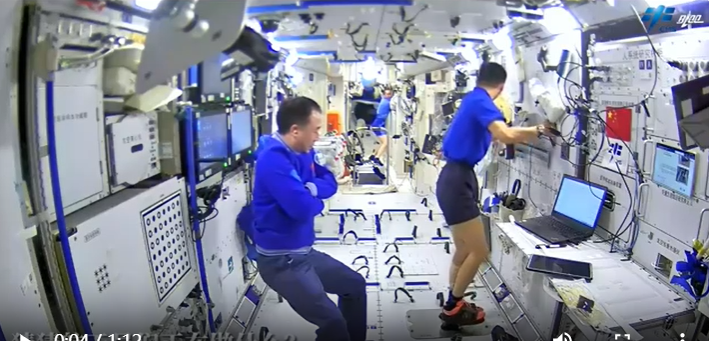How Taikonauts Exercise in Space
By?Staff?Reporters

Taikonauts?exercise?in?space station Tiangong.?(PHOTO:?Screenshot?from?XINHUA)
When the China Manned Space Engineering Office recently released an exercise video of the three Chinese astronauts in space station Tiangong following their arrival via the Shenzhou-16 aircraft in May, their specialized biomimetic adhesive shoes fascinated the viewers.
The footwear, which at first glance look like ordinary are a key part of the space exercise gear of astronauts, known as taikonauts in China.
Pang Zhihao, an expert on space exploration technology and a renowned writer, explained how the shoes work to Science and Technology Daily.
According to Pang, when astronauts wear these shoes and step onto specially designed pedals, adhesion makes the shoes stick to the pedals. To lift their feet, the astronauts have to make considerable effort, thus creating a workout effect. Also, the muscle sensors embedded in the shoes enable quantitative monitoring of muscle and bone stimulation during physical activity.
For astronauts, maintaining a regular exercise regime is very important as they have to stay for long periods in space where they become weightless due to the absence of the gravitational force. When astronauts aged between 30 and 50 stay in space for long without any exercise, their muscles atrophy severely.
Besides, the reduced pressure on bones in microgravity sends misleading signals to the body, leading to excess calcium excretion through urine and feces, resulting in bone demineralization. This increases the risk of kidney stone formation and vascular calcification.
Research has shown that after a year in space, astronauts upon returning to Earth require approximately one month to recover the lost muscle mass. Additionally, they may lose up to 25 percent of their total body calcium, which may take two to three years to replenish fully.
To mitigate these challenges, China's space missions typically last for around six months to minimize the impact on astronauts' health. Various exercise facilities are available inside space stations to enable astronauts to target different muscle groups for physical training.






